What Gets You Better and What Keeps You Better
Thomas A. M. Kramer, MDLike so many of the illnesses that cause human suffering, we have no cure for bipolar disorder. We are blessed with numerous treatments, but none of them represents a cure. The distinction is crucial. Treatments are interventions that improve or, at best, ameliorate the natural course of the disorder. The disorder, however, remains. Treatments do not take it away, they simply make it easier to live with. A cure, when we get one, will not only relieve all of the signs and symptoms, it will reverse and eliminate the disease process, leaving the patient completely free of the disease. I am not sure whether I shall see such a cure in my lifetime, but there is nothing to indicate that it will be available in the near future.
Treatment of bipolar disorder is further complicated by the fact that there appears to be no specific pharmacologic or psychological treatment that is effective for all patients at all phases of the illness. Different patients respond to different medications and psychotherapies and usually require different treatments at different phases of their illness. Polypharmacy in the treatment of bipolar disorder is, whether we like it or not, the standard of care. Most patients require more than one medication at any given point in time, and if they are able to be stabilized on a single medication, it is reasonable to predict that monotherapy will not be effective for them indefinitely.
The fact that different patients respond differentially to different medications is ubiquitous in psychopharmacology. The main reason why there are multiple medications for schizophrenia or depression, for example, is that any given medication will not be effective for all patients, but most patients will respond to one of them. What holds bipolar disorder in some degree of contradistinction is that some medications are more or less effective for different phases of the illness, such as mania or depression, and there appears to be a distinction between agents that are more or less effective for acute phases of the illness and those that are more or less effective for prophylaxis, or the maintenance phase of the illness.
As a result of this distinction, it may be less useful in discussing treatments for bipolar disorder to make some sort of judgment about whether something is effective or not. Any given agent may be enormously effective for one phase of the illness but ineffective for another. In particular, that which gets you better may be something completely different from that which keeps you better. This is somewhat different from the treatment of other psychiatric illnesses in that, generally, the same medications are used for all phases of the illness.
Many agents have shown utility and efficacy in the treatment of acute mania. Pretty much anything that slows the patient down, constricts mood, or helps them organize their thinking has at least the potential to be a therapeutic agent for mania. In my clinical experience, simply getting a manic patient to get a reasonable night's sleep has enormous therapeutic benefit. There are numerous medications that help people sleep. In a more direct sense, there are many published studies about agents being effective for the treatment of acute mania, including both first- and second-generation antipsychotics and US Food and Drug Administration (FDA)-approved and putative mood stabilizers. It is important to note that virtually all of these studies are 6 weeks long and looked only at the extent to which manic symptoms were attenuated by the medication being studied. Almost always, no attention was paid to any other symptoms outside of mania or any efficacy regarding maintenance.
The treatment of bipolar depression has received a great deal of attention lately, after having received virtually none for the preceding time. This is probably due to the fact that we had virtually no established treatments or study data, since all the work was being done on the treatment of acute mania. This situation is, in effect, a corollary to the great truism, "when all you have is a hammer, everything looks like a nail"; the assumption was made that if something was effective in the treatment of acute mania, it was effective in general as a treatment for bipolar disorder. We are now considerably more knowledgeable about the treatment of bipolar depression, particularly with regard to the impact of antidepressants. It seems relatively clear that antidepressants, at least in monotherapy, make switches from depression to mania more likely, increase the frequency of cycling, and increase the likelihood of a mixed dysphoric state. The extent to which they should be used in combination with a mood stabilizer as a treatment for bipolar depression remains controversial. There are some data that say they can be used safely and effectively to prevent depressive relapse in this combination, yet some clinicians still shy away from them in general. It is important to note that they have this luxury now because we have treatments for bipolar depression, such as lamotrigine and perhaps some or all of the second-generation antipsychotics, which may be effective for bipolar depression without the problems of conventional antidepressants described above.
A larger issue for treatment selection for bipolar disorder is the potential differentiation between treatments for acute states vs treatments for maintenance prophylaxis. Obviously, it is much more difficult to do a study demonstrating efficacy in maintenance than it is in acute treatment. Not only is the maintenance study longer, but, given the cycling, relapsing and remitting nature of bipolar disorder, it can be very difficult to design a study in which the active drug group separates significantly from the placebo group. Many clinicians, including myself, are confident that valproate is a very effective maintenance drug for bipolar disorder; however, it does not have this indication from the FDA and recent published studies have been remarkably equivocal on this issue. On the other hand, lamotrigine has not shown great efficacy in the treatment of acute mania but does have the indication from the FDA for both bipolar depression and maintenance of bipolar disease for prophylaxis of both mania and depression on the basis of clinical trial data. Second-generation antipsychotics have shown great promise in the treatment of both acute mania and the maintenance phase of the illness, although some of the agents initially used for this purpose, such as olanzapine or clozapine, were prone to causing weight gain or metabolic syndrome with long-term use. Now we have more and potentially safer choices for maintenance use, with relatively new positive data for quetiapine, ziprasidone, and aripiprazole.
Many questions remain. What is the best treatment or cocktail of treatments for the various phases of bipolar disorder? We have clues, but certainly no definitive answers. Bipolar disorder has many subtypes that respond differentially to different medications. As we are better able to differentiate the subtypes, we should be better able to differentiate the treatments. There may also be medications originally studied only for the treatment of acute mania that may be less than effective for acute mania but may have real potential as maintenance prophylaxis drugs. As we step away from the paradigm that medications useful in the treatment of bipolar disease must be useful for all phases of the treatment of bipolar disease, we may be blessed with many more possibilities for our patients.
Thomas A. M. Kramer, MD, Associate Professor of Psychiatry, University of Chicago, Chicago, Illinois
Treatment of bipolar disorder is further complicated by the fact that there appears to be no specific pharmacologic or psychological treatment that is effective for all patients at all phases of the illness. Different patients respond to different medications and psychotherapies and usually require different treatments at different phases of their illness. Polypharmacy in the treatment of bipolar disorder is, whether we like it or not, the standard of care. Most patients require more than one medication at any given point in time, and if they are able to be stabilized on a single medication, it is reasonable to predict that monotherapy will not be effective for them indefinitely.
The fact that different patients respond differentially to different medications is ubiquitous in psychopharmacology. The main reason why there are multiple medications for schizophrenia or depression, for example, is that any given medication will not be effective for all patients, but most patients will respond to one of them. What holds bipolar disorder in some degree of contradistinction is that some medications are more or less effective for different phases of the illness, such as mania or depression, and there appears to be a distinction between agents that are more or less effective for acute phases of the illness and those that are more or less effective for prophylaxis, or the maintenance phase of the illness.
As a result of this distinction, it may be less useful in discussing treatments for bipolar disorder to make some sort of judgment about whether something is effective or not. Any given agent may be enormously effective for one phase of the illness but ineffective for another. In particular, that which gets you better may be something completely different from that which keeps you better. This is somewhat different from the treatment of other psychiatric illnesses in that, generally, the same medications are used for all phases of the illness.
Many agents have shown utility and efficacy in the treatment of acute mania. Pretty much anything that slows the patient down, constricts mood, or helps them organize their thinking has at least the potential to be a therapeutic agent for mania. In my clinical experience, simply getting a manic patient to get a reasonable night's sleep has enormous therapeutic benefit. There are numerous medications that help people sleep. In a more direct sense, there are many published studies about agents being effective for the treatment of acute mania, including both first- and second-generation antipsychotics and US Food and Drug Administration (FDA)-approved and putative mood stabilizers. It is important to note that virtually all of these studies are 6 weeks long and looked only at the extent to which manic symptoms were attenuated by the medication being studied. Almost always, no attention was paid to any other symptoms outside of mania or any efficacy regarding maintenance.
The treatment of bipolar depression has received a great deal of attention lately, after having received virtually none for the preceding time. This is probably due to the fact that we had virtually no established treatments or study data, since all the work was being done on the treatment of acute mania. This situation is, in effect, a corollary to the great truism, "when all you have is a hammer, everything looks like a nail"; the assumption was made that if something was effective in the treatment of acute mania, it was effective in general as a treatment for bipolar disorder. We are now considerably more knowledgeable about the treatment of bipolar depression, particularly with regard to the impact of antidepressants. It seems relatively clear that antidepressants, at least in monotherapy, make switches from depression to mania more likely, increase the frequency of cycling, and increase the likelihood of a mixed dysphoric state. The extent to which they should be used in combination with a mood stabilizer as a treatment for bipolar depression remains controversial. There are some data that say they can be used safely and effectively to prevent depressive relapse in this combination, yet some clinicians still shy away from them in general. It is important to note that they have this luxury now because we have treatments for bipolar depression, such as lamotrigine and perhaps some or all of the second-generation antipsychotics, which may be effective for bipolar depression without the problems of conventional antidepressants described above.
A larger issue for treatment selection for bipolar disorder is the potential differentiation between treatments for acute states vs treatments for maintenance prophylaxis. Obviously, it is much more difficult to do a study demonstrating efficacy in maintenance than it is in acute treatment. Not only is the maintenance study longer, but, given the cycling, relapsing and remitting nature of bipolar disorder, it can be very difficult to design a study in which the active drug group separates significantly from the placebo group. Many clinicians, including myself, are confident that valproate is a very effective maintenance drug for bipolar disorder; however, it does not have this indication from the FDA and recent published studies have been remarkably equivocal on this issue. On the other hand, lamotrigine has not shown great efficacy in the treatment of acute mania but does have the indication from the FDA for both bipolar depression and maintenance of bipolar disease for prophylaxis of both mania and depression on the basis of clinical trial data. Second-generation antipsychotics have shown great promise in the treatment of both acute mania and the maintenance phase of the illness, although some of the agents initially used for this purpose, such as olanzapine or clozapine, were prone to causing weight gain or metabolic syndrome with long-term use. Now we have more and potentially safer choices for maintenance use, with relatively new positive data for quetiapine, ziprasidone, and aripiprazole.
Many questions remain. What is the best treatment or cocktail of treatments for the various phases of bipolar disorder? We have clues, but certainly no definitive answers. Bipolar disorder has many subtypes that respond differentially to different medications. As we are better able to differentiate the subtypes, we should be better able to differentiate the treatments. There may also be medications originally studied only for the treatment of acute mania that may be less than effective for acute mania but may have real potential as maintenance prophylaxis drugs. As we step away from the paradigm that medications useful in the treatment of bipolar disease must be useful for all phases of the treatment of bipolar disease, we may be blessed with many more possibilities for our patients.
Thomas A. M. Kramer, MD, Associate Professor of Psychiatry, University of Chicago, Chicago, Illinois
























